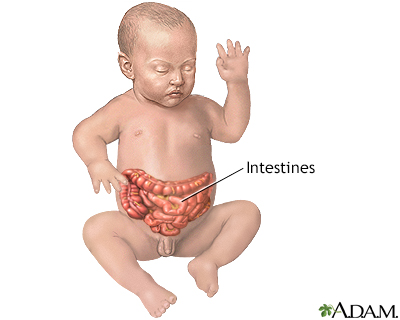Necrotizing enterocolitis
Necrotizing enterocolitis (NEC) is the death of tissue in the intestine. It occurs most often in premature or sick babies.
Images

I Would Like to Learn About:
Causes
NEC occurs when the lining of the intestinal wall dies. This problem nearly always develops in an infant who is ill or premature. It is likely to occur while the infant is still in the hospital.
The exact cause of this disorder is unknown. A drop in blood flow to the bowel can damage the tissue. Bacteria in the intestine may also add to the problem. Also, premature infants have an undeveloped immune response to factors such as bacteria or low blood flow. An imbalance in immune regulation appears to be involved in NEC.
Babies at higher risk for the condition include:
- Premature infants
- Infants who are fed formula rather than human milk. (Human milk contains growth factors, antibodies and immune cells which may help prevent the problem.)
- Infants in a nursery where an outbreak has occurred
- Infants who have received blood exchange transfusions or have been seriously ill
Symptoms
Symptoms may come on slowly or suddenly, and may include:
- Abdominal bloating
- Blood in the stool
- Diarrhea
- Feeding problems
- Lack of energy
- Unstable body temperature
- Unstable breathing, heart rate, or blood pressure
- Vomiting
Exams and Tests
Tests may include:
- Abdominal x-ray
- Stool for occult blood test
- Complete blood count (CBC)
- Electrolyte levels, blood gases and other blood tests
Treatment
Treatment for a baby who may have NEC most often includes:
- Halting enteral (GI tract) feedings
- Relieving gas in the bowel by inserting a tube in the stomach
- Giving IV fluids and nutrition
- Giving IV antibiotics
- Monitoring the condition with abdominal x-rays, blood tests, and measurement of blood gases
The infant will need surgery if there is a hole in the intestines or inflammation of the abdominal wall (peritonitis).
In this surgery, the doctor will:
The bowel may be reconnected after several weeks or months when the infection has healed.
Outlook (Prognosis)
Necrotizing enterocolitis is a serious disease. Up to 40% of infants with NEC die from it. Early, aggressive treatment can help improve the outcome.
Possible Complications
Complications may include:
- Peritonitis
- Sepsis
- Intestinal perforation
- Intestinal stricture
- Liver problems from prolonged inability to tolerate enteral feeds and need for parenteral (IV) nutrition
- Short bowel syndrome if a large amount of intestine is lost
When to Contact a Medical Professional
Get emergency medical care if any symptoms of necrotizing enterocolitis develop. Infants who are hospitalized for illness or prematurity are at higher risk for NEC. They are watched closely for this problem before they are sent home.
Related Information
SepsisIntestinal obstruction and Ileus
References
Greenberg JM, Narendran V, Brady JM, Nathan AT, Haberman B. Neonatal morbidities of prenatal and perinatal origin. In: Lockwood CJ, Copel JA, Dugoff L et al, eds. Creasy and Resnik's Maternal-Fetal Medicine: Principles and Practice. 9th ed. Philadelphia, PA: Elsevier; 2023:chap 73.
Kudin O, Neu J. Neonatal necrotizing enterocolitis. In: Martin RJ, Fanaroff AA, Walsh MC, eds. Fanaroff and Martin's Neonatal-Perinatal Medicine. 11th ed. Philadelphia, PA: Elsevier; 2020:chap 85.
Seed PC. The microbiome and pediatric health. In: Kliegman RM, St. Geme JW, Blum NJ, Shah SS, Tasker RC, Wilson KM, eds. Nelson Textbook of Pediatrics. 21st ed. Philadelphia, PA: Elsevier; 2020:chap 196.
BACK TO TOPReview Date: 4/28/2023
Reviewed By: Neil K. Kaneshiro, MD, MHA, Clinical Professor of Pediatrics, University of Washington School of Medicine, Seattle, WA. Also reviewed by David C. Dugdale, MD, Medical Director, Brenda Conaway, Editorial Director, and the A.D.A.M. Editorial team.

Health Content Provider
06/01/2025
|
A.D.A.M., Inc. is accredited by URAC, for Health Content Provider (www.urac.org). URAC's accreditation program is an independent audit to verify that A.D.A.M. follows rigorous standards of quality and accountability. A.D.A.M. is among the first to achieve this important distinction for online health information and services. Learn more about A.D.A.M.'s editorial policy, editorial process and privacy policy. A.D.A.M. is also a founding member of Hi-Ethics. This site complied with the HONcode standard for trustworthy health information from 1995 to 2022, after which HON (Health On the Net, a not-for-profit organization that promoted transparent and reliable health information online) was discontinued. |
The information provided herein should not be used during any medical emergency or for the diagnosis or treatment of any medical condition. A licensed medical professional should be consulted for diagnosis and treatment of any and all medical conditions. Links to other sites are provided for information only -- they do not constitute endorsements of those other sites. © 1997- 2025 A.D.A.M., a business unit of Ebix, Inc. Any duplication or distribution of the information contained herein is strictly prohibited.
